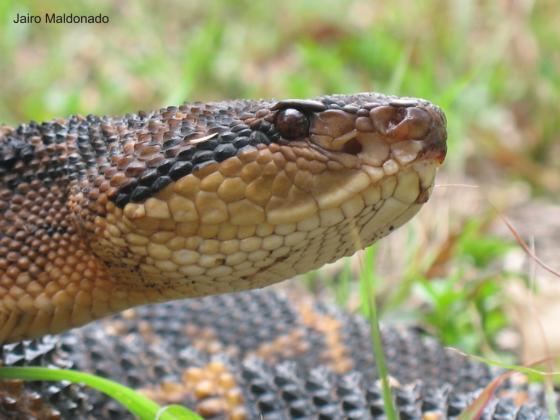Subphylum Vertebrata Suborder Serpentes Scientific name Lachesis Length 30 cm (Hatchling) Clutch size 12 | Phylum Chordata Family Viperidae Mass 3 – 5 kg (Large Adult) Higher classification Pit viper Rank Genus | |
 | ||
Lower classifications Lachesis muta, Lachesis stenophrys, Lachesis melanocephala | ||
Description
Adults vary in length from 2 to 3 m (6.6 to 9.8 ft), although some may grow to as much as 4 m (13 ft). The largest known specimen was just under 4.5 m (15 ft), making it the longest venomous snake in the Western Hemisphere. Bushmasters are the longest type of viper in the world. L. muta is possibly the largest of the three species currently recognized, although more scant information suggest L. stenophrys broadly overlaps in size and may average at a similar size, while L. melanocephala is slightly smaller than the other two species. Although they are not the heaviest vipers, being surpassed in mass by the gaboon viper and the Eastern diamondback rattlesnake, large adults still can weigh up to 3 to 7 kg (6.6 to 15.4 lb). Bushmasters are sexually dimorphic in size, with males reaching larger sizes than females. The bushmaster's tail ends with a horny spine which it sometimes vibrates when disturbed in a manner similar to rattlesnakes. This led to some calling it 'the mute rattlesnake'.
Contents
Geographic range
Found in Central and South America, including the island of Trinidad.
Reproduction
Bushmasters lay eggs: about a dozen in an average clutch. The female reportedly remains with her eggs during incubation and may aggressively defend the nest if approached. The hatchlings average 30 cm (12 in) in length and are more colorful than the adults. Lachesis is thought to be unique among New World pit vipers by laying eggs rather than giving birth to live young, although some evidence suggests that the species Bothrocophias colombianus found in Colombia may do the same.
Venom
This snake is capable of multiple-bite strikes and the injection of large amounts of venom. Even the bite of a juvenile specimen can be fatal. However, this snake is rarely encountered so snakebite incidents are not common.
Species
*) Not including the nominate subspecies.
T) Type species.
Taxonomy
Campbell and Lamar (2004) also recognize a fourth species, L. acrochorda (García, 1896), referring to it as the Chochoan bushmaster. It is found in western Panama and northwestern Colombia and Ecuador. Its evolutionary relationships are not certain, but Lachesis acrochorda is thought to be closer to the South American bushmaster L. muta than to the two Central American species L. stenophrys and L. melanocephala. The snake is known to be one of the deadliest snakes in the world.
Cultural depictions
The bushmaster snake is the antagonist in the tenth show of the old time radio show Escape. The show's title was "A Shipment of Mute Fate", and starred Jack Webb and Raymond Lawrence. It was broadcast on 15 October 1947. The story was also adapted for Suspense starring Jack Kelly, broadcast on January 6, 1957. Jack T. Colton killed a bushmaster in the film Romancing the Stone when seeking shelter in a crashed plane.
The following weapons and military vehicles are named after this viper:
